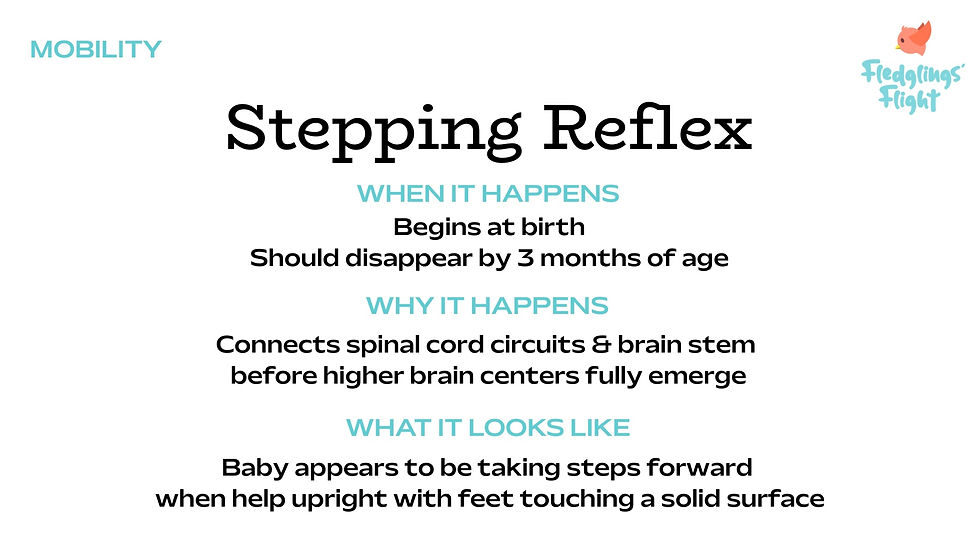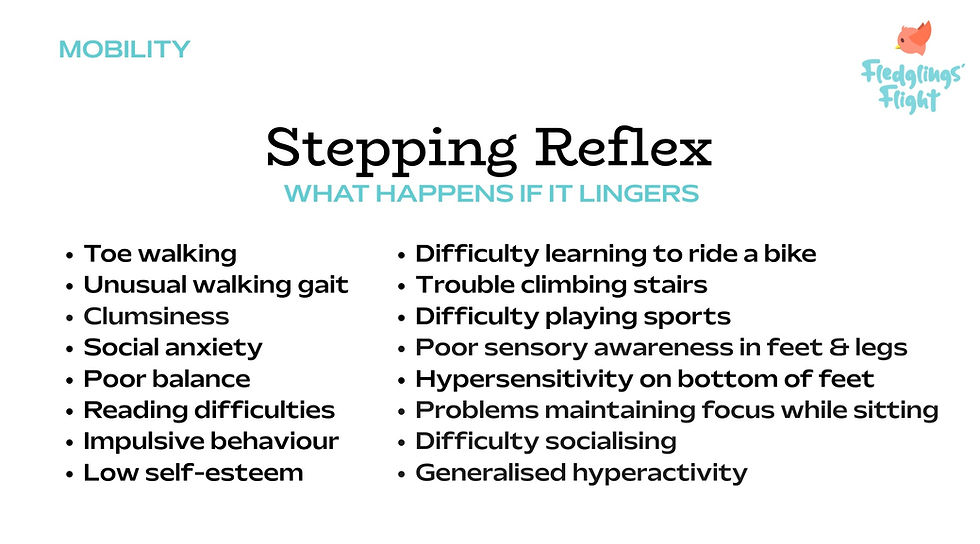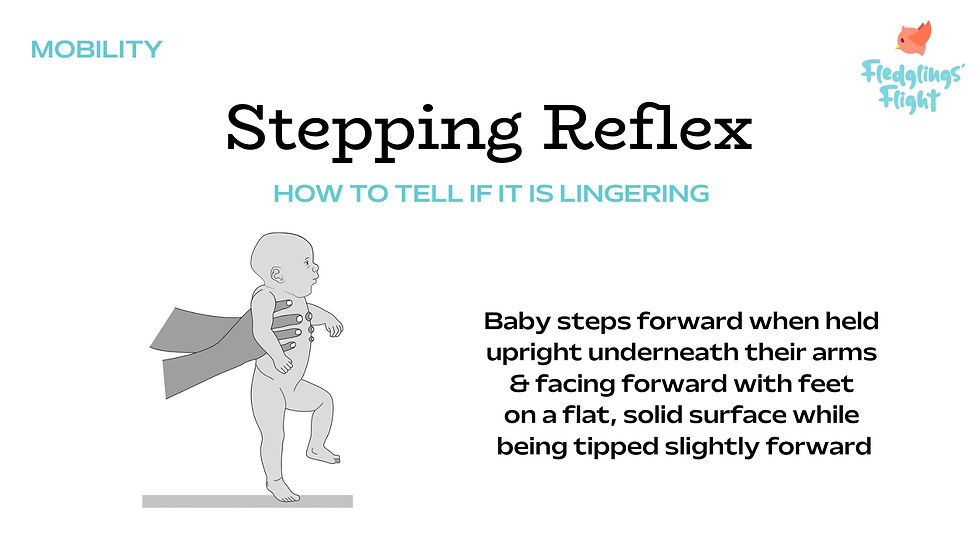Step by Step: How the Stepping Reflex Lays the Foundation for Walking
- Kaylie Estrada
- Sep 23, 2025
- 3 min read
Updated: Sep 30, 2025
The Stepping Reflex helps your baby practice early walking movements.

What are primitive reflexes?
Babies are born with a remarkable set of automatic movements called primitive reflexes. These reflexes develop in the womb and help newborns feed, move, and respond to their environment. While they are only temporary, they are important in laying the foundation for intentional movement, learning, and emotional growth.
Reflexes like the Sucking and Rooting reflexes help with feeding, while protective reflexes such as the Moro prepare infants to react to sudden changes. Mobility reflexes including the Plantar, and Spinal Galant are there to get the body ready for crawling, standing, and walking. Part of this group is the Stepping Reflex, which helps your baby in developing the movements and strength needed to walk in the future.

What is the Stepping Reflex?
The Stepping Reflex appears at birth and can be seen when a baby is held upright with their feet touching a flat surface. As their body tilts slightly forward, they will make small, automatic stepping motions. According to the National Library of Medicine, "... the stepping reflex is thought to be a precursor to walking, providing infants with the neural patterns and muscular practice needed for future locomotion," [1].
This reflex is an important part of early motor development because it allows babies to exercise their legs and begin coordinating movements long before they are ready to walk on their own. By practicing these small stepping motions, they are able to strengthen their muscles and improve their balance which prepares them for more complex milestones like standing and walking.
The reflex usually fades by about 3 months of age, allowing more intentional motor skills to take its place.

What happens if the Stepping Reflex Lingers?
When the Stepping Reflex remains active beyond early infancy, it can interfere with many areas of development. Children may struggle with walking and balance and even show signs of toe-walking. These difficulties can extend into mobility and sports, making everyday tasks like climbing stairs or participating in physical activities more challenging. Some children may also experience sensory issues, including poor awareness of their feet and legs or heightened sensitivity on the soles of their feet.
Beyond physical effects, a retained reflex may impact their learning and attention spans. This may make it harder to sit still and focus. A retained reflex may also effect their social growth and make it difficult for them to make friends. They might show signs of low self esteem and impulsive behaviors. In certain cases, lingering reflexes are linked to hyperactivity, demonstrating how closely movement, sensory development, and cognition are connected in shaping a child’s overall growth.

How to test for a retained Stepping Reflex
To check for the Stepping Reflex, hold your baby upright with their feet touching a flat surface. In newborns, this should trigger an automatic stepping motion. The reflex normally fades around 3 months of age, so if you notice that your child continuing to make these movements past this point, or if they develop any of the issues listed above, it may be a sign that the reflex hasn’t fully integrated. Observing these patterns can give you helpful insight, and sharing your concerns with a pediatrician is always a step in the right direction.

What can you do about a retained Stepping Reflex?
If you suspect your child’s Stepping Reflex is still active, being aware is the most important part! Pediatricians and physical therapists can assess whether the reflex is present and recommend strategies to help. Many specialists use simple, play-based exercises that strengthen coordination and body awareness, all of which or important in integrating reflexes.
With the right guidance, children can overcome these challenges and developing greater confidence in movement and a stronger foundation for learning, play, and much more.
Sources:
Lewis, R. (2020, May 19). What are the primitive reflexes and how are they useful? Healthline. https://www.healthline.com/health/baby/primitive-reflexes?utm
Brain Balance Centers. Retained Primitive Reflexes as a Sign of Brain Imbalance. https://www.brainbalancecenters.com/blog/retained-primitive-reflexes-sign-brain-imbalance
Melillo, Robert, et al. “Retained Primitive Reflexes and Potential for Intervention in Autistic Spectrum Disorders.” Frontiers in Neurology, vol. 13, July 2022, https://doi.org/10.3389/fneur.2022.922322.
Understanding Primitive Reflexes: A Dynamic Perspective on Sensory Motor Development. (n.d.). Sensory Health. https://sensoryhealth.org/node/2060

Want more information like this?
Create a free account with Fledglings' Flight and get access to 4820 screen-free, play-based exercises. That is 100-200 exercises each month that you can start doing with your baby from the day that they are born to help them to develop into the best version of themselves. In addition, your free account gives you access to 1200+ articles on child development to keep you informed while you help to navigate your child's developmental journey.




Comments